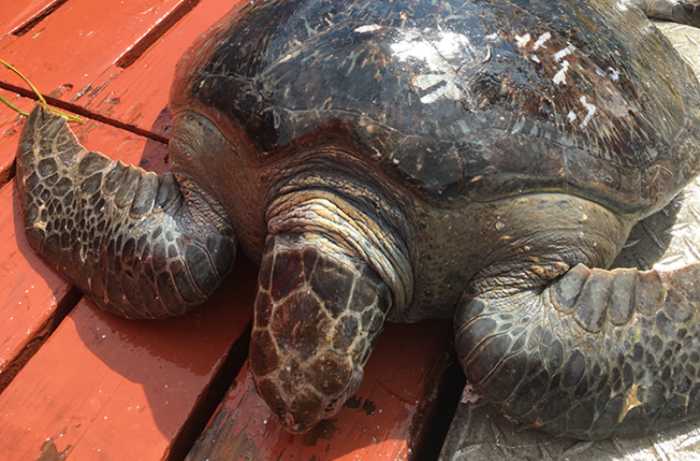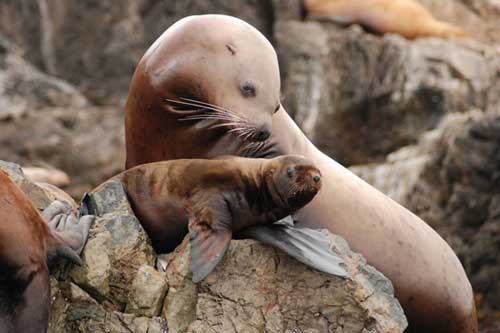Beluga Whale (Cook Inlet DPS): Endangered
Listed: 2008
Beluga whales are highly social, gregarious animals found in Arctic and subarctic waters. They weigh around 3,150 pounds, reach 16 feet long, and can live up to 90 years. One of the most vocal of all whales, with their chirps and squeals, belugas are often called “sea canaries.” They can swim backwards and change the shape of their “melon” forehead by blowing air into their sinuses. Cook Inlet beluga whales are the smallest of the other distinct populations of beluga whales. They face threats from human interactions, habitat constraint, climate change, human-caused noise, predation, and prey limitations. The population’s rapid decline, dire status, and the fact the population is not recovering makes it a priority for NOAA Fisheries. Cook Inlet beluga whales are one of NOAA Fisheries’ Species in the Spotlight—considered the most at risk of extinction in the near future.
Blue Whale (Eastern North Pacific Population): Endangered
Listed: 1970
Blue whales are the largest animal ever recorded on earth. They weigh up to 330,000 pounds, reach 100 feet, and can live up to 90 years. Everything about blue whales is large! They have a 400-pound heart and a tongue as big as an elephant. They have the biggest calves on the planet, which weigh almost 9,000 pounds at birth and gain 200 pounds a day. The biggest blue whales may eat up to 12,000 pounds of krill a day, straining huge volumes of water through their baleen plates. Blue whale calls can travel up to 1,000 miles underwater. The Eastern North Pacific population faces threats from entanglement in fishing gear, ocean noise, and vessel strikes.
Bowhead Whale (Western Arctic Stock): Endangered
Listed: 1970
Bowhead whales may live more than 200 years, the longest lifespan of all mammals. They can weigh 200,000 pounds and reach 62 feet. Bowhead whales are one of the few whale species that reside almost exclusively in Arctic and subarctic waters. Their name stems from their immense bow-shaped heads that are used to break through 2-foot-thick sea ice. The Western Arctic stock faces threats from climate change, contaminants, entanglement in fishing gear, ocean noise, offshore oil and gas development, predation, and vessel strikes.
Fin Whale (North Pacific Population): Endangered
Listed: 1970
Fin whales are the second largest whale species. As the fastest of all baleen whales sustaining speeds as high as 23 miles per hour, they have been nicknamed the “greyhound of the sea.” They are also sometimes referred to as razorbacks due to their small pointed dorsal fin and shape of their back. They can weigh up to 160,000 pounds, reach 85 feet long, and live 80 to 90 years. A fin whale uses 50 to 100 accordion-like throat pleats to gulp large amounts of food and water and eats about 4,000 pounds of food daily. The North Pacific population faces threats from climate change, entanglement in fishing gear, lack of prey due to overfishing, ocean noise, and vessel strikes.
Gray Whale (Western North Pacific Distinct Population Segment): Endangered
Listed: 1970
Gray whales do not have a dorsal fin, but they have 6 to 12 bumps, called “knuckles,” between the dorsal hump and the tail fluke. They weigh 90,000 pounds and can reach up to 49 feet; their lifespan is unknown. Gray whales are the only baleen whale that forages along the ocean floor by rolling on their sides and swimming slowly to suck in sediment and food. They face threats from climate change, entanglement in fishing gear, habitat impacts, ocean noise, predation, and vessel strikes. A small proportion of the Western North Pacific DPS migrate across the Bering Sea into Alaskan waters.
Humpback Whales—Western North Pacific: Endangered; Mexico: Threatened
Listed: 1970
Humpback whales can hunt in small groups using a method called bubble-net feeding. They dive deep and swim up in a circular pattern while releasing a curtain of bubbles from their blowholes to corral schools of fish. They weigh 80,000 pounds, can reach 60 feet long, and live between 80 and 90 years. Male humpback whales are known for their shared vocalizations. Their complex songs can last 20 minutes but will repeat for hours and carry up to 3,000 miles. Research shows that songs change gradually over the years, and all singing males within the same population will adapt to the new song. The Western North Pacific and Mexico distinct population segments face threats from entanglement in fishing gear, ocean noise, vessel strikes, and vessel-based harassment.
North Pacific Right Whale: Endangered
Listed: 1970
The North Pacific right whale is one of the most endangered large whale species and one of the rarest marine mammals worldwide. They weigh up to 200,000 pounds, reach 64 feet long, and live up to 70 years. They are one of the slowest whales, only reaching speeds of about 2.5 miles per hour. North Pacific right whales are the only right whale species known to sing. They are threatened by biotoxins, climate change, entanglement in fishing gear, marine debris, ocean noise, oil and gas development, and vessel strikes.
Sei Whale: Endangered
Listed: 1970
Sei whales are among the fastest of all cetaceans with speeds of more than 34 miles per hour. They can weigh 100,000 pounds, reach 60 feet long, and live between 50 and 70 years. Sei whales dive by sinking below the surface, unlike other whales that arch their backs or show their flukes. Their scientific name, Balaenoptera borealis, means “northern winged whale” as the shape and position of their pectoral fins give them the appearance of being winged. Climate change, entanglement in fishing gear, ocean noise, and vessel strikes are all threats to the species.
Sperm Whale: Endangered
Listed: 1970
Sperm whales are the largest of the toothed whales. They use echolocation to navigate and hunt for food during deep dives of more than 10,000 feet for more than 60 minutes. Sperm whales can live to 60 years and are different sizes depending on gender: females are roughly 30,000 pounds and 40 feet long, while males are 90,000 pounds and 52 feet long. With a brain 500 cubic inches in size and weighing up to 20 pounds, it has the largest brain of any animal ever living. They are the loudest animal on the planet, producing clicks and echolocations that measure more than 200 decibels. They sleep vertically, suspended in “drift dives” just below the water’s surface. Sperm whales face threats from climate change, entanglement in fishing gear, marine debris, ocean noise, oil spills and contaminants, and vessel strikes.
Arctic Ringed Seal: Threatened
Listed: 2013
Ringed seals are the smallest Arctic seal. They can weigh up to 150 pounds, are roughly 4 feet long, and some can live to more than 40 years. Ringed seals are are found o sea ice for giving birth to and nursing pups, and also for resting. Ringed seals use their sharp claws to make and maintain breathing holes in the ice; they are the only kind of Arctic seal to do this. They face threats from climate change, increased shipping activity, and offshore oil and gas exploration/development.








